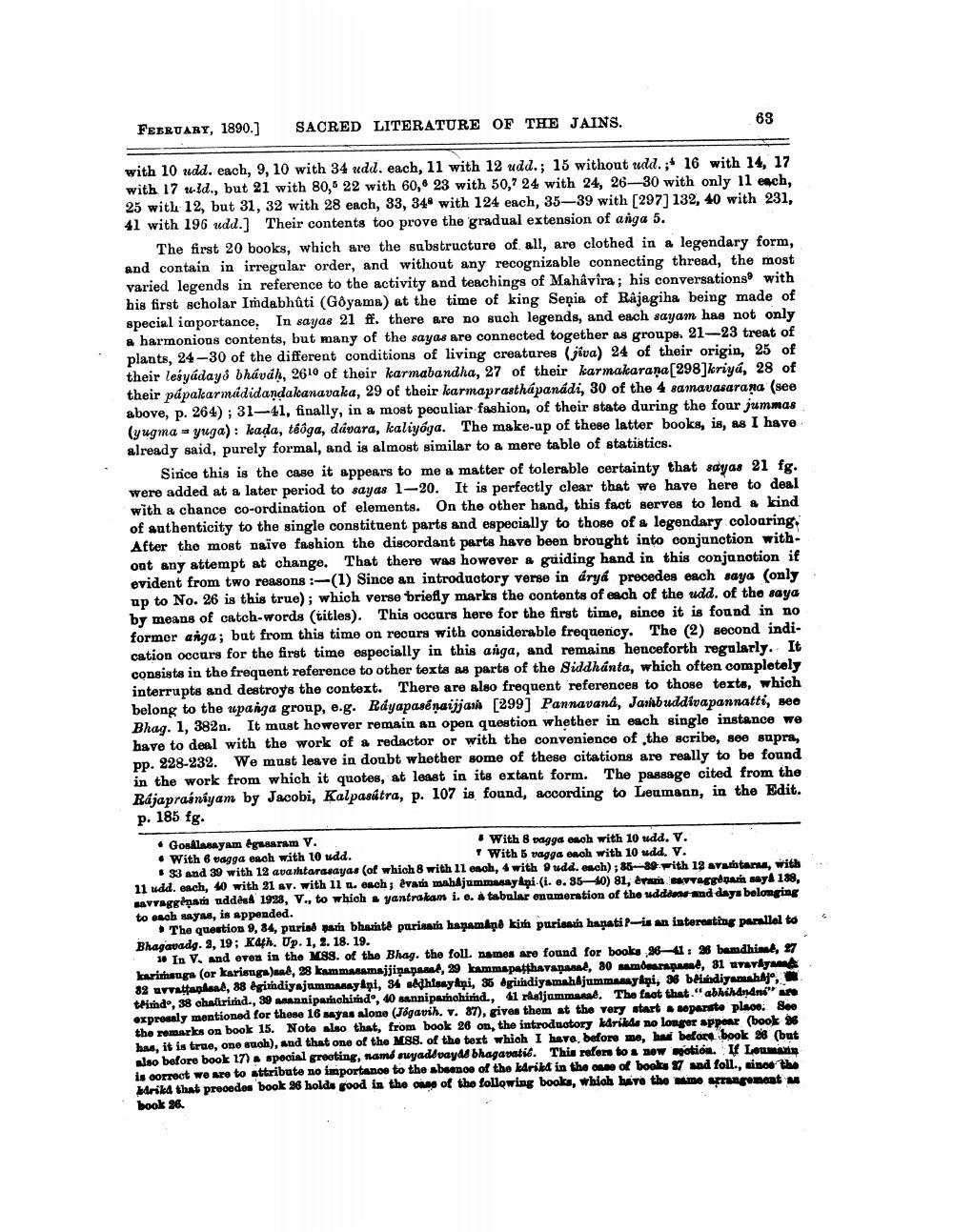________________
FEBRUARY, 1890.]
SACRED LITERATURE OF THE JAINS.
63
with 10 udd. each, 9, 10 with 34 udd. each, 11 with 12 udd.; 15 without add. ;* 16 with 14, 17 with 17 -1d., but 21 with 80,5 22 with 60, 23 with 50,7 24 with 24, 26-30 with only Il each, 25 with 12, but 31, 32 with 28 each, 33, 34° with 124 each, 35-39 with [297] 132, 40 with 231, 41 with 196 udd.] Their contents too prove the gradual extension of anga 5.
The first 20 books, which are the substructure of all, are clothed in a legendary form, and contain in irregular order, and without any recognizable connecting thread, the most varied legends in reference to the activity and teachings of Mahavira; his conversations with his first scholar Imdabhùti (Gôyama) at the time of king Seņia of Rajagiha being made of special importance. In sayas 21 ff. there are no such legends, and each sayam has not only a harmonious contents, but many of the sayas are connected together as groups. 21-23 treat of plants, 24-30 of the different conditions of living creatures (jiva) 24 of their origin, 25 of their leśyádaybháváh, 2610 of their karmabandha, 27 of their karmakarana[298]kriyá, 28 of their pápakarmádidandakanavaka, 29 of their karmaprasthápanádi, 30 of the 4 samavasarana (see above, p. 264); 31-41, finally, in a most peculiar fashion, of their state during the four jummas (yugma yuga): kada, taiga, dávara, kaliyóga. The make-up of these latter books, is, as I have already said, purely formal, and is almost similar to a mere table of statistics.
Sirice this is the case it appears to me a matter of tolerable certainty that sayas 21 fg. were added at a later period to sayas 1-20. It is perfectly clear that we have here to deal with a chance co-ordination of elements. On the other hand, this fact serves to lend & kind of authenticity to the single constituent parts and especially to those of a legendary colouring After the most naïve fashion the discordant parts have been brought into conjunction with ont any attempt at change. That there was however & guiding hand in this conjunotion if evident from two reasons :-(1) Since an introductory verse in áryá precedes each saya (only up to No. 26 is this true); which verse briefly marks the contents of each of the udd. of the saya by means of catch-words (titles). This occurs here for the first time, since it is found in no former anga; but from this time on recurs with considerable frequency. The (2) second indication occurs for the first time especially in this auga, and remains henceforth regularly. It consists in the frequent reference to other texts as parts of the Siddhánta, which often completely interrupts and destroys the context. There are also frequent references to those texta, which belong to the upanga group, e.g. Rayapasénaijjani [299] Pannavana, Jashbuddivapannatti, seo Bhag. 1, 382n. It must however remain an open question whether in each single instance we have to deal with the work of a redactor or with the convenience of the scribe, see supra, pp. 228-232. We must leave in doubt whether some of these citations are really to be found in the work from which it quotes, at least in its extant form. The passage cited from the Rájapraéniyam by Jacobi, Kalpasútra, p. 107 is found, according to Leumaan, in the Edit. p. 185 fg. • Goshlasayam égusaram V.
With 8 pagga ench with 10 udd. V. • With 6 vagga esch with 10 udd.
7 With 5 vagga ench with 10 udd. V. 33 and 39 with 12 avantarasayas (of which 8 with 11 each, 4 with 9 udd. each); 86-89 with 12 avatars, with 11 udd. each, 40 with 21 av. with 11 u. each; evan mahkjummasayapi.(i. e. 8540) 81, eram savvugg para sayl 188, Havvagginan uddes 1928, V., to which yantrakan i. e. & tabular enumeration of the udddons and days belonging to each sayas, is appended.
The question 9, 34, puriad maria bhainte purisaria hapamad kim purienn hanati-is an interesting parallel to Bhagavadg. 2, 19; kath. Up. 1, 2. 18. 19.
*In V, and even in the MSS. of the Bhag. the foll. names are found for books 26-128 bamdhimat, 27 baritsuga (or karisuga)sal, 28 kammasamajjinapaasd, 29 kammapatthavanaand, 80 samar pesat, 81 uvarkymo 82 arvatapland, 88 egitndiyajummasaylpi, 34 sedhisayfpi, 86 dgiidiyamah jumsakyki, 36 bendiyamshijo, . thimdo, 38 challrimd., 39 annipanchimdo, 40 sannipazhohimnd., 41 raljammand. The fact that." abhindrani" An or proualy mentioned for these 16 sayas alone (Jógavih. v. 87), gives them at the very start soparst place. See the remarks on book 15. Noto also that, from book 26 on, the introductory kdrikde no longer appear (book 36 hu, it is true, one such), and that one of the M88. of the text which I havo, before mo, had before book 28 (but
Iso before book 17). special greeting, samd ruyadivayas bhaganatic. This refers to a new motion. Louma is correct we are to attribute no importance to the absence of the karike in the use of books and foll., since the karika that prooedos book 26 holda good in the one of the following books, whioh have the memo rangement M book 26.




